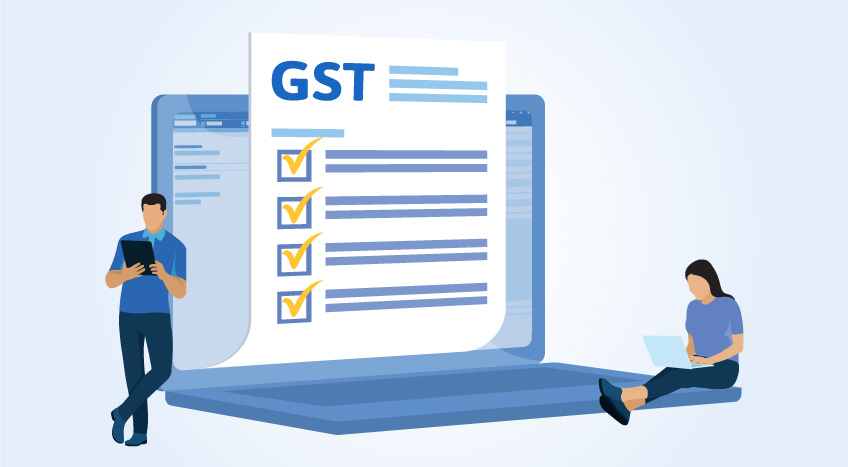- Introduction
- GST Returns Forms - At a Glance
- How to file GST return online?
- Who should file GST return?
- FAQ
For every GSTIN registered under India’s GST regime, taxpayers must file a GST return. In total, 22 types of GST returns are prescribed under GST Rules. Of these, currently:
- 11 are active
- 3 are suspended
- 8 are view-only
Let’s explore the types of GST returns, their purpose, and due dates.
GST Return Forms with Due Dates
Under the CGST Act 2017, specific return forms are prescribed, each with defined filing frequencies and deadlines.
|
S.No |
Form No. |
Purpose |
Frequency |
Due Date |
|
1 |
Details of outward supplies |
Monthly / Quarterly |
11th of next month / 13th after quarter |
|
|
2 |
GSTR-3B |
Monthly summary return (tax liability & credit claim) |
Monthly / Quarterly (QRMP) |
20th next month / 22nd or 24th for QRMP |
|
3 |
GSTR-4 |
Annual return for composition taxpayers |
Annually |
30th of month after FY |
|
4 |
CMP-08 |
Self-assessed statement-cum-payment for composition dealers |
Quarterly |
18th next month |
|
5 |
GSTR-5 |
Return for non-resident taxable persons |
Monthly |
20th next month |
|
6 |
GSTR-5A |
Return for OIDAR services by persons outside India |
Monthly |
20th next month |
|
7 |
GSTR-6 |
Return for Input Service Distributors (ISD) |
Monthly |
13th next month |
|
8 |
GSTR-7 |
TDS return under GST |
Monthly |
10th next month |
|
9 |
GSTR-8 |
TCS return by e-commerce operators |
Monthly |
10th next month |
|
10 |
GSTR-9 |
Annual return for regular taxpayers |
Annually |
31st Dec of next FY |
|
11 |
GSTR-9C |
Reconciliation statement for audited taxpayers (turnover > ₹2 Cr) |
Annually |
31st Dec of next FY |
|
12 |
GSTR-11 |
Return by UIN holders claiming refund |
Monthly |
28th of next month |
Other returns like GSTR-6A, GSTR-9A, and GSTR-10 apply in specific scenarios.
When to File GST Returns?
GST return filing is mandatory even if there’s no transaction during the period (NIL return).
Important:
- You cannot file the current return if the previous return is pending.
- Late filing attracts interest & late fees, impacting compliance.
Interest & Late Fees under GST
- Interest: 18% p.a. on outstanding tax, calculated from the next day after due date till payment.
- Late fee: ₹100/day under CGST + ₹100/day under SGST (₹200/day; max ₹5,000). For NIL returns: reduced to ₹20/day.
How to file GST returns in India?
You can file the GST return online as follows.
Step 1: Register for GSTIN
For those taxpayers who are not registered, you need to register to get the GSTIN number. It is a 15-digit number that is generated based on your state code of operation and PAN.
Step 2: Log in to the GST portal
You must log in to the GST portal using your username and password and then click on the tab called ‘Services’.
Step 3: Go to the Returns Dashboard
Navigate to: Services → Returns → Returns Dashboard.
Choose the financial year and the specific month or quarter for which you're filing.
Step 4: Select the Right Return Form
Pick the appropriate return form based on your business type and the filing period:
GSTR-1: Outward supplies (sales)
GSTR-3B: Tax summary (monthly)
Other forms (e.g., GSTR-4, GSTR-7) if applicable to your setup
Step 5: Prepare the Return
Click "Prepare Online" (or use upload options if you have one):
For GSTR-1, enter invoice details (B2B, B2C, exports, credit/debit notes, etc.)
For GSTR-3B, the portal auto-populates data using GSTR-1 and GSTR-2B. Review and confirm your liability.
Step 6: Validate & Submit
Validate all entries and ensure accuracy.
For GSTR-1, click "Generate Summary", then "Submit".
For final submission, choose either:
DSC (Digital Signature Certificate) — mandatory for companies/LLPs
EVC (Electronic Verification Code) sent to your registered mobile/email
Step 7: Payment (if applicable)
After submission, check your electronic ledger balance and clear any due tax.
The portal may prompt you to create a challan if your cash ledger balance is insufficient.
You can pay via net banking, OTC (cash/cheque/DD), or NEFT/RTGS.
Step 8: Receive Acknowledgment
A successful submission generates an ARN (Application Reference Number).
You’ll receive confirmation via SMS and email.
Step 9: Download Filed Return
Download the filed return in PDF format for your records.
You may also download invoice summaries (especially for GSTR-1) in Excel if needed.
Under GST, there are 19 GST return forms, which tax payers can use to file GST returns online. All these forms are required to be e-filed as per the GST return filing process laid down in the GST return rules section of the GST Act. The details of each of these GST return formats, along with details of applicability and periodicity, are as follows -
GST Returns Forms - At a Glance
|
Category |
GST Return Types |
Frequency |
Due Date |
Details to be Furnished |
|
Regular Dealer |
Form GSTR-1 |
Monthly |
10th of succeeding month |
Furnish details of outward supplies of taxable goods and/or services affected |
|
Form GSTR-2A |
Monthly |
On 11th of succeeding Month |
Auto-populated details of inward supplies made available to the recipient on the basis of Form GSTR-1 furnished by the supplier |
|
|
Form GSTR-2 |
Monthly |
15th of succeeding month |
Details of inward supplies of taxable goods and/or services for claiming the input tax credit. Addition (Claims) or modification in Form GSTR-2A should be submitted in Form GSTR-2. |
|
|
Form GSTR-1A |
Monthly |
17th of succeeding month |
Details of outward supplies as added, corrected or deleted by the recipient in Form GSTR-2 will be made available to the supplier |
|
|
Form GSTR-3 |
Monthly |
20th of succeeding month |
Monthly return on the basis of finalization of details of outward supplies and inward supplies along with the payment of the amount of tax |
|
|
Form GST MIS-1 |
Monthly |
— |
Communication of acceptance, discrepancy or duplication of input tax credit claim |
|
|
Form GSTR-3A |
— |
15 Days from Default |
Notice to a registered taxable person who fails to furnish returns |
|
|
Form GSTR-9 |
Annually |
31st Dec of next fiscal |
Annual Return – furnish the details of ITC availed and GST paid which includes local, interstate and import/exports |
|
|
Composite Tax Payer |
Form GSTR-4A |
Quarterly |
— |
Details of inward supplies made available to the recipient registered under composition scheme on the basis of Form GSTR-1 furnished by the supplier |
|
Form GSTR-4 |
Quarterly |
18th of succeeding month |
Furnish all outward supply of goods and services. This includes auto-populated details from Form GSTR-4A, tax payable and payment of tax. |
|
|
Form GSTR-9A |
Annual |
31st Dec of next fiscal |
Furnish the consolidated details of quarterly returns filed along with tax payment details. |
|
|
Foreign Non-Resident Taxpayer |
Form GSTR-5 |
Monthly |
20th of succeeding month or within 7 days after the expiry of the registration |
Furnish details of imports, outward supplies, ITC availed, tax paid, and closing stock |
|
Persons providing online information and database access or retrieval services |
Form GSTR-5 |
Monthly |
20th of succeeding month |
Details of outward supplies of online information and database access or retrieval services by a person located outside India made to non-taxable persons in India |
|
Input Service Distributor |
Form GSTR-6A |
Monthly |
0n 11th of succeeding month |
Details of inward supplies made available to the ISD recipient on the basis of Form GSTR-1 furnished by the supplier |
|
Form GSTR-6 |
Monthly |
13th of succeeding month |
Furnish the details of input credit distributed |
|
|
Tax Deductor |
Form GSTR-7 |
Monthly |
10th of succeeding month |
Furnish the details of TDS deducted |
|
Form GSTR-7A |
Monthly |
TDS certificate to be made available for download |
TDS Certificate – capture details of value on which TDS is deducted and deposit on TDS deducted into appropriate Govt. |
|
|
E-commerce |
Form GSTR-8 |
Monthly |
10th of succeeding month |
Details of supplies effected through e-commerce operator and the amount of tax collected on supplies |
|
Form GSTR-9B |
Annually |
31st Dec of next fiscal |
An annual statement containing the details of outward supplies of goods or services or both effected through an e-commerce operator, including the supplies of goods or services or both returned and the amount collected under |
|
|
Aggregate Turnover Exceeds INR 2 Crores |
Form GSTR-9C |
Annually |
Annual, 31st Dec of next fiscal |
Reconciliation Statement – audited annual accounts and a reconciliation statement, duly certified. |
|
Final Return |
Form GSTR-10 |
Monthly |
Within 3 months from the date of cancellation of registration or date of cancellation Order, whichever is later |
Furnish details of inputs and capital goods held, tax paid and payable. |
|
Specialised agency of the United Nations Organisation or any multilateral Financial Institution and notified United Nations Bodies, Consulate or Embassy of foreign countries |
Form GSTR-11 |
Monthly |
28th of succeeding month |
Details of inward supplies to be furnished by a person having UIN |
Who Should File GST Return?
Under the GST Act, any taxable person who has set up a business in India must register and file GST returns. This applies to all types of entities, including:
- Individuals
- Hindu Undivided Families (HUF)
- LLPs and Companies
- Local Authorities
- Trusts and Societies
- Cooperative Societies
- AOPs/BOIs (Association or Body of Individuals)
Basically, if you are engaged in trade, commerce, or any kind of economic activity, you need to comply with GST filing rules.
How Often Do Businesses Need to File GST Returns?
The frequency of GST returns depends on your business turnover and chosen scheme:
For businesses with turnover up to ₹5 crores
- You can opt for the QRMP scheme (Quarterly Return, Monthly Payment).
- You must file 9 returns per year: 4 × GSTR-1 (quarterly);4 × GSTR-3B (quarterly);1 × Annual return
For businesses with turnover above ₹5 crores (or not opting for QRMP)
You must file GST returns twice a month + 1 annual return. That means a total of 25 GST returns per year.
Special cases like composition dealers and certain taxpayers may have different filing requirements as per GST rules.
Upcoming dates to file GST return
|
Return form |
Due date |
Filing frequency |
|
GSTR-1 |
11th day of the next month |
Monthly |
|
13th day of the month after the quarter |
Quarterly for those under QRMP scheme |
|
|
IFF (optional according to the QRMP scheme) |
13th day of the next month |
Monthly (for the initial two months of the quarter) |
|
GSTR-3B |
20th day of the next month |
Monthly |
|
For those with annual aggregate turnover less than or equal to Rs. 5 crore who also have opted for the QRMP scheme the 22nd day of the month after the quarter for category X states and UTs, and 24th day of the month after the quarter for category Y states and UTs |
Quarterly for those under QRMP scheme |
|
|
CMP-08 |
18th day of the month after the quarter |
Quarterly |
|
GSTR-4 |
30th day of the month after the financial year |
Annually |
|
GSTR-5 |
20th day of the next month |
Monthly |
|
GSTR-5A |
20th day of the next month |
Monthly |
|
GSTR-6 |
13th day of the next month |
Monthly |
|
GSTR-7 |
10th day of the next month |
Monthly |
|
GSTR-8 |
10th day of the next month |
Monthly |
|
GSTR-9 |
31st December of succeeding financial year |
Annually |
|
GSTR-9C |
31st December of succeeding financial year |
Annually |
|
GSTR-10 |
Within three months since the cancellation |
Once only when cancellation or surrendering occurs |
|
GSTR-11 |
28th day of the month that comes after the month during which the statement was filed |
Monthly |
|
ITC-04 |
25th April |
Annually (for AATO less than and equal to Rs. 5 crore) |
|
25th October and 25th April |
Half-yearly (for AATO more than Rs. 5 crore) |
Bottom Line
Understanding GST return types, due dates, and compliance requirements is crucial for businesses to avoid penalties and stay GST-compliant.
Explore how TallyPrime helps automate GST return preparation and filing.
FAQs
Is CA required to file GST returns?
Earlier, it was mandatory for businesses with an aggregate annual turnover of more than Rs. 5 crores to get audit certification from CAs. However, now the CBIC has declared that such businesses can self-certify their GST return. GST returns can be filed on your behalf by a CA and but it is not mandatory for businesses. As GST rules and regulations are many, it is advisable that businesses hire a CA or a software tool that eases the filing process for minimal errors.
Can I file my own GST returns?
You can file your GST returns yourself if you wish but as there are many careful considerations that need to be kept in mind when filing the returns, it is best if you take the help of an experienced CA or a software tool. You can use a robust solution such as TallyPrime that automatically checks for errors so you can rectify them prior to filing your GST returns. It also enables you to generate GST-compliant invoices for hassle-free GST return filing later on.
Do we need to file GST returns every month?
The GSTR-1 is required to be filed on a monthly basis unless you have opted for the QRMP scheme. The GSTR-1 must be filed by every single normal registered taxable person. GSTR-1 doesn’t need to be filed by the input service distributor, the composition taxpayer, the persons liable to deduct tax.
How many types of GST returns are there in India?
There are 22 types prescribed; currently, 11 are active, 3 are suspended, and 8 are view-only.
What is the due date for GSTR-3B?
It’s the 20th of next month. For QRMP taxpayers, it’s the 22nd or 24th after the quarter, based on the state.
Do I need to file GST returns even with no transactions?
Yes, NIL returns must be filed to avoid late fees and keep compliance active.
What happens if I delay filing GST returns?
You must pay interest (18% p.a.) and late fees (₹200/day; reduced for NIL returns).
How can TallyPrime help in GST compliance?
TallyPrime automates data capture, reconciles GSTR data, enables direct filing, and tracks outstanding ITC, simplifying GST compliance.
Read More on GST Returns
Types of GST Returns, New GST Returns & Forms, Sahaj GST Returns, Sugam GST Returns, GSTR 1, GSTR 2, GSTR 3B, GSTR 4, GSTR 5, GSTR 5A, GSTR 6, GSTR 7, GSTR 8, GSTR 9, GSTR 10, GSTR 11
GST
GST Software, GST Calculator, GST on Freight, GST on Ecommerce, GST Impact on TCS, GST Impact on TDS, GST Exempted Goods & Services, Reverse Charge Mechanism in GST, GST Declaration, GST Compliance, GST Record Keeping
Types of GST
CGST, SGST, IGST, UTGST, Difference between CGST, SGST & IGST
GST Rates & Charges
GST Rates, GST Rate Finder, GST Rate on Labour Charges, HSN Codes, SAC Codes, GST State Codes

















